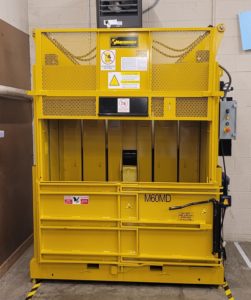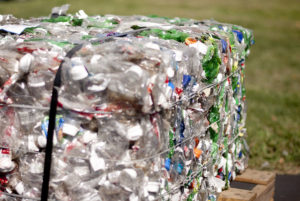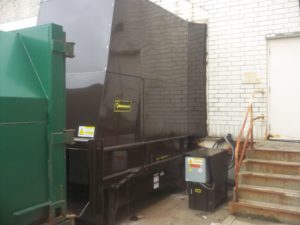Some people who are new to the recycling and waste management industry may not fully understand the difference between balers and compactors. If you have a business that produces any type of waste or recyclable material that needs to be disposed of, both a baler and a compactor can help make this process easier and more cost effective. But you do need to know the difference between baler and compactors before attempting to implement the most optimal solution for your business!
Similarities & Differences Between Balers & Compactors

This M60MD Low Profile Baler installed in Lone Tree, CO is being used to make up to 800 lb. bales of cardboard.
Balers and compactors are both designed to reduce the volume of materials placed into the machine. They each have one or more hydraulic cylinders that force a platen (sometimes called a ram) against the material to be compressed, reducing it in size. Both balers and compactors help to reduce the space taken up by these materials, eliminate fire and vermin hazards caused by them, and lower the time and expense needed by employees to handle them. And, both require you to sort the product to be compressed before loading it into the machine.
The main difference between balers and compactors is that they are used to process different materials. Balers are used to manage recyclable commodities that are bound for storage and shipping by using baling wire or twine. Compactors are used to reduce the size of the trash, allowing for more waste to be hauled away at a time. This reduces the amount of space taken up in landfills, the amount of carbon used by hauling trucks with fewer pulls, and the cost of hauling away fewer loads per month.
When you Need a Baler – Recyclable Materials
Recycling balers are used to compress and bundle (or bale) recyclable materials such as cardboard, paper, plastics, non-ferrous metals, shrink wrap, foam, carpet, textiles, and more! The materials are made into dense and consistently shaped bales for easy storage and transport. They can range in size from 30″ up to 72″ and even greater with custom bales. Eventually the bales of recyclable materials are brought to a recycling company for resale and reuse.
Some balers are specifically designed to perforate, drain, and bale out-of-spec liquids and other products stored in aluminum, plastics, or TetraPak containers. These liquid extraction balers help businesses dispose of products like soda pop, water, energy drinks, shampoo, soups, and more according to government regulations and specifications.
Balers can be vertical or horizontal in configuration. They can be manually or automatically fed with conveyor or tipper systems.
When you Need a Compactor – Trash
In contrast, a compactor is used to reduce and compress large volumes of trash into a contained area before the waste hauling company picks it up and delivers it to the landfill. Compactors can reduce the overall number of trash pickups because compacted trash takes up less space! They reduce odor, vermin, pilferage, and fire hazards.
Stationary compactors handle dry waste, while self-contained compactors are designed to manage both wet and dry waste. Both can be configured with a wide variety of compactor feeding configurations to meet your exact business needs. These can be walk on decks, doghouses, hopper fed, tipper fed, custom made, and more.
Now you Decide – Compactor or Baler?
With an understanding of both balers and compactors, you can start to determine which piece of equipment is right for your business needs. Harmony Enterprises, Inc. manufactures a wide range of waste handling and recycling solutions. Our knowledgeable sales team can help you decide which piece of equipment will help you create the greatest efficiency for your operations. We offer no-obligation site reviews and needs assessments as part of our proven sales process.
Please Contact Us Here or call us at 507-886-6666 if we can help you decide which compactor or baler is right for your specific waste compacting needs. At Harmony Enterprises, Inc. our goal is to help people and businesses recycle and reduce waste by providing the right equipment for the job, ultimately improving the environment across the globe.


